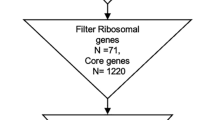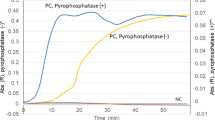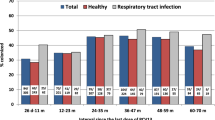Abstract
The authors implemented a PCR protocol to rapidly screen for Pasteurella pneumotropica and to accurately identify contaminated laboratory mice in a clinical setting. This protocol was implemented in response to a severe outbreak of P. pneumotropica in their animal facility. Although a sentinel program was in place to routinely screen for P. pneumotropica, it was inadequate for the identification of contaminated animals. As a result, several additional strains of mice were contaminated and developed clinical signs of infection. The authors implemented a screening method using PCR with reported primer pairs previously developed to identify the biotype isolates of P. pneumotropica in laboratory mice. Throat culture swabs were collected from live mice and placed in a bacterial culture. The DNA from these cultures was isolated and screened by PCR. This procedure enabled the authors to eliminate P. pneumotropica from several animal housing rooms. The assay can be easily applied in most animal facilities.
This is a preview of subscription content, access via your institution
Access options
Subscribe to this journal
We are sorry, but there is no personal subscription option available for your country.
Buy this article
- Purchase on Springer Link
- Instant access to full article PDF
Prices may be subject to local taxes which are calculated during checkout



Similar content being viewed by others
References
Hayashimoto, N. et al. Identification procedure for Pasteurella pneumotropica in microbiologic monitoring of laboratory animals. Exp. Anim. 54, 123–129 (2005).
Hayashimoto, N., Ueno, M., Takakura, A. & Itoh, T. A specific polymerase chain reaction based on the gyrB gene sequence and subsequent restriction fragment length polymorphism analysis of Pasteurella pneumotropica isolates from laboratory mice. J. Am. Assoc. Lab. Anim. Sci. 46, 54–58 (2007).
Macy, J.D. Jr., Weir, E.C., Compton, S.R., Shlomchik, M.J. & Brownstein, D.G. Dual infection with Pneumocystis carinii and Pasteurella pneumotropica in B cell-deficient mice: diagnosis and therapy. Comp. Med. 50, 49–55 (2000).
Franklin, C.L. Microbial considerations in genetically engineered mouse research. ILAR J. 47, 141–155 (2006).
National Research Council. Infectious Diseases of Mice and Rats (National Academy Press, Washington, DC, 1991).
Hansen, A.K. Handbook of Laboratory Animal Bacteriology (CRC Press, Washington, DC, 2000).
Carter, G.R. in Diagnostic Procedures in Veterinary Bacteriology and Mycology 5th edn. (eds. Carter, J. & Cole, J.R. Jr.) 133–134 (Academic, San Diego, CA, 1990).
Compton, S.R., Homberger, F.R. & MacArthur, C.J. Microbiological monitoring in individually ventilated cage systems. Lab. Anim. 33, 36–41 (2004).
Dole, V.S., Banu, L.A., Fister, R.D., Nicklas, W. & Henderson, K.S. Assessment of rpoB and 16S rRNA genes as targets for PCR-based identification of Pasteurella pneumotropica. Comp. Med. 60, 427–435 (2010).
Salmon, S.A., Watts, J.L., Walker, R.D. & Yancey, R.J. Jr. Evaluation of a commercial system for the identification of gram-negative, nonfermenting bacteria of veterinary importance. J. Vet. Diagn. Invest. 7, 161–164 (1995).
Remel RapID NF Plus System information booklet (Remel, Lenexa, KS, 2007).
Scharmann, W. & Heller, A. Survival and transmissibility of Pasteurella pneumotropica. Lab. Anim. 35, 163–166 (2001).
Boot, R., Van den Brink, M., Handgraaf, P. & Timmermans, R. The use of the API 20 NE bacteria classification procedure to identify Pasteurellaceae strains in rodents and rabbits. Scand. J. Lab. Anim. Sci. 31, 177–183 (2004).
Jawetz, E.A. Pneumotropic Pasteurella of laboratory animals. I. Bacteriological and serological characteristics of the organism. J. Infect. Dis. 86, 172–183 (1950).
Hasegawa, M. et al. Evaluation of a forced-air-ventilated micro-isolation system for protection of mice against Pasteurella pneumotropica. Exp. Anim. 52, 145–151 (2003).
Holmes, B. et al. in Manual of Clinical Microbiology 7th edn. (eds. Murray, P.R. & American Society for Microbiology) 632–637 (ASM Press, Washington, DC, 1999).
Clifford, C.B. & Clifford, C. Samples, sample selection, and statistics: living with uncertainty. Lab. Anim. 30, 26–31 (2001).
Shek, W.R. Role of housing modalities on management and surveillance strategies for adventitious agents of rodents. ILAR J. 49, 316–325 (2008).
Miller, J.M. & O'Hara, C.M. in Manual of Clinical Microbiology 7th edn. (eds. Murray, P.R. & American Society for Microbiology) 193–201 (ASM Press, Washington, DC, 1999).
Acknowledgements
We thank Christian Demers, Richard Ashby and Dr. Jean-François Cloutier for their careful revision of the manuscript and Drs. Christine Vande Velde and Emmanuelle Brocheiro for permission to use their mice.
Author information
Authors and Affiliations
Corresponding author
Ethics declarations
Competing interests
The authors declare no competing financial interests.
Rights and permissions
About this article
Cite this article
Ouellet, M., Cowan, M., Laporte, A. et al. Implementation of a PCR assay of Pasteurella pneumotropica to accurately screen for contaminated laboratory mice. Lab Anim 40, 305–312 (2011). https://doi.org/10.1038/laban1011-305
Received:
Accepted:
Published:
Issue Date:
DOI: https://doi.org/10.1038/laban1011-305



